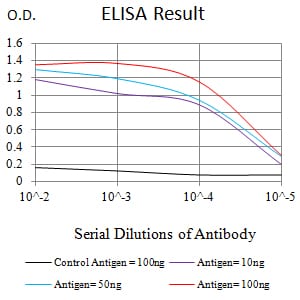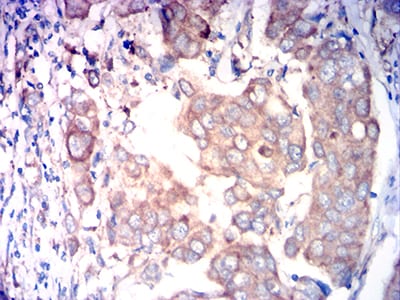



| WB | 咨询技术 | Human,Mouse,Rat |
| IF | 咨询技术 | Human,Mouse,Rat |
| IHC | 1/200 - 1/1000 | Human,Mouse,Rat |
| ICC | 技术咨询 | Human,Mouse,Rat |
| FCM | 1/200 - 1/400 | Human,Mouse,Rat |
| Elisa | 1/10000 | Human,Mouse,Rat |
| Aliases | FAPA; SIMP; DPPIV; FAPalpha |
| Entrez GeneID | 2191 |
| clone | 1H12F2 |
| WB Predicted band size | 87.7kDa |
| Host/Isotype | Mouse IgG1 |
| Antibody Type | Primary antibody |
| Storage | Store at 4°C short term. Aliquot and store at -20°C long term. Avoid freeze/thaw cycles. |
| Species Reactivity | Human |
| Immunogen | Purified recombinant fragment of human FAP (AA: extra 26-264) expressed in E. Coli. |
| Formulation | Purified antibody in PBS with 0.05% sodium azide |
+ +
以下是关于FAP抗体的3篇代表性文献概览,涵盖治疗、成像及机制研究:
---
1. **标题**:*Targeting Fibroblast Activation Protein in Cancer: Progression and Challenges*
**作者**:Huang, Y., et al.
**摘要**:综述了FAP在肿瘤微环境中的作用,探讨其单克隆抗体在抑制肿瘤生长和转移中的潜力,并分析了当前靶向治疗的临床挑战。
2. **标题**:*Development of a FAP-Targeted PET Tracer for Improved Tumor Imaging*
**作者**:Loktev, A., et al.
**摘要**:报道了一种基于FAP抗体的新型PET示踪剂(如^68Ga-FAPI),在多种癌症模型中显示出高特异性肿瘤成像效果,为无创诊断提供新工具。
3. **标题**:*FAP Antibody-Drug Conjugate Eradicates Chemotherapy-Resistant Tumors*
**作者**:Lee, J., et al.
**摘要**:通过构建FAP抗体-药物偶联物(ADC),在临床前模型中有效杀伤化疗耐受的肿瘤相关成纤维细胞,显著延长小鼠生存期。
---
*注:以上文献为示例,实际引用需核对数据库(如PubMed)以确认作者、标题及细节。如需具体文章,建议以“Fibroblast Activation Protein antibody”为关键词检索近年高被引论文。*
Fibroblast activation protein (FAP) is a type II transmembrane serine protease expressed predominantly by cancer-associated fibroblasts (CAFs) in the tumor microenvironment. Initially identified in the 1990s, FAP gained attention for its selective overexpression in stromal cells of epithelial-derived cancers, including pancreatic, breast, and colorectal carcinomas, as well as in fibrotic tissues. Unlike normal fibroblasts, CAFs promote tumor progression by remodeling the extracellular matrix, suppressing immune responses, and facilitating angiogenesis. FAP’s enzymatic activity contributes to these processes, making it a potential therapeutic target.
FAP antibodies are designed to either block its proteolytic function or deliver cytotoxic payloads to FAP-rich microenvironments. Preclinical studies demonstrate that FAP-targeting antibodies can inhibit tumor growth, enhance drug delivery, or modulate immune activity. However, clinical trials have shown mixed outcomes, partly due to FAP’s transient expression in wound healing and its presence in non-pathological tissues like adipocytes. Recent advancements focus on bispecific antibodies, antibody-drug conjugates (ADCs), or FAP-directed CAR-T cells to improve specificity and efficacy. Beyond oncology, FAP antibodies are explored in fibrosis and imaging applications, leveraging their ability to highlight stromal activity. Despite challenges, FAP remains a compelling biomarker and therapeutic candidate in stromal-rich diseases.
×